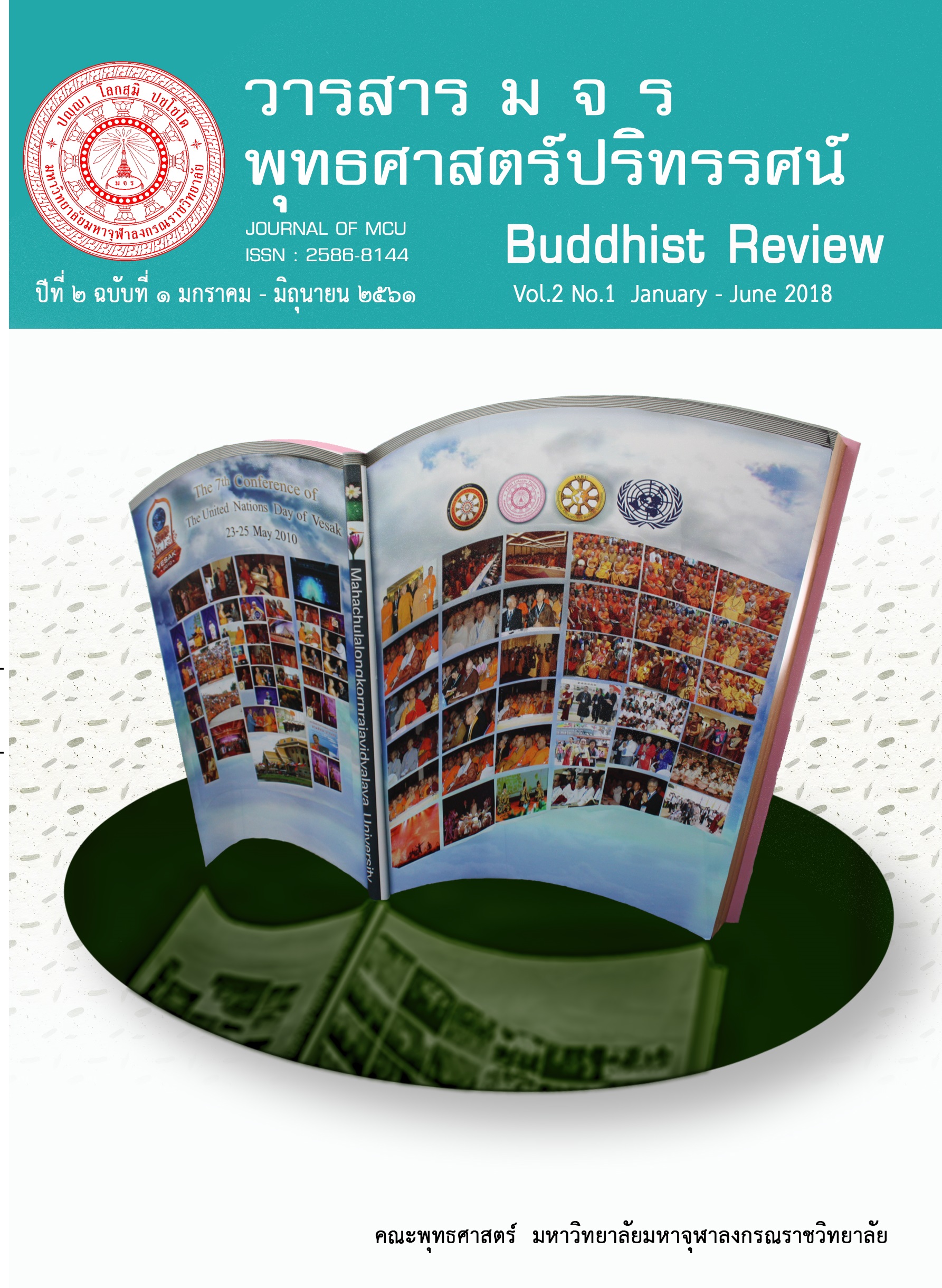หลักการและวิธีการล้างบาปในพระพุทธศาสนา
Main Article Content
บทคัดย่อ
บทความนี้มีเป้าหมายศึกษาวิเคราะห์ความเชื่อเกี่ยวกับการล้างบาปและวิธีการล้างบาปตามหลักการของพระพุทธศาสนา การล้างบาปซึ่งคนทั่วไปเข้าใจได้รับข้อมูลมาจากความเชื่อแบบศาสนาเทวนิยมซึ่งมีอิทธิพลต่อสังคมไทยตั้งแต่สมัยโบราณบวกกับการคิดด้วยเหตุผลแบบไม่ครบถ้วนนำไปสู่มโนทัศน์เรื่องการล้างบาป คำสอนเรื่องการล้างบาปนี้เกิดจากความเชื่อที่ว่า มนุษย์มีตัวตนถาวรในฐานะผู้รับรู้และเป็นผู้ได้รับอารมณ์ ความคิดดังกล่าวจัดเป็นสักกายทิฏฐิ อยู่ในมิจฉาทิฏฐิซึ่งเป็นตัวปิดกั้นไม่ให้เกิดปัญญาและยังนาไปสู่ความทุกข์ และการปล่อยให้ตัวตนยึดติดความคิดเช่นนั้นโดยการยึดถือความเป็นตัวตนและสิ่งที่เกี่ยวข้องกับตนอยู่ตลอดเวลา หลักคำสอนของพระพุทธเจ้ามีเป้าหมายเพื่อสร้างปัญญาและพัฒนาสติปัญญาให้รู้ความจริงของตัวตนหรืออัตตาและสิ่งที่เนื่องกับอัตตาตามหลักไตรลักษณ์เพื่อทาลายความไม่รู้ กลุ่มเจ้าลัทธิต่าง ๆ ที่ไม่เข้าใจธรรมชาติของอัตตาต่างหวาดกลัวเพราะเชื่อว่าตัวตนเป็นสิ่งไม่สมบูรณ์เนื่องจากมีบาปติดตัวมาก่อนจึงถือการล้างบาปเป็นสิ่งสาคัญในการชาระล้างตัวตนให้บริสุทธิ์ได้ ความเชื่ออย่างนี้จัดเป็นความคิดคือสังขารอย่างหนึ่งซึ่งตกอยู่ในไตรลักษณ์ การล้างบาปที่ถูกต้องคือการสร้างสติปัญญาทาลายความยึดมั่นถือมั่นและมิจฉาทิฏฐิในจิตของปัจเจกบุคคลก่อนโดยการพัฒนาจิตให้มีสติและสัมปชัญญะจนละกิเลส ซึ่งเป็นเหตุของบาปด้วยการเจริญวิปัสสนาภาวนาเพื่อบรรลุมรรค ผลและนิพพาน การพัฒนาสติรู้ความเป็นจริงจนบรรลุนิพพานถือเป็นการล้างบาปได้อย่างแท้จริง
Article Details
- บทความที่ได้รับการตีพิมพ์เป็นลิขสิทธิ์ของวารสาร มจร พุทธศาสตร์ปริทรรศน์
- ข้อความใดๆ ที่ปรากฎในบทความที่ได้รับการตีพิมพ์ในวารสาร ถือเป็นความรับผิดชอบของผู้เขียนบทความ และข้อคิดเห็นนั้นไม่ถือว่าเป็นทัศนะและความรับผิดชอบของกองบรรณาธิการวารสาร มจร พุทธศาสตร์ปริทรรศน์
เอกสารอ้างอิง
พระโสภณมหาเถระ (มหาสีสยาดอ).วิปัสสนาชุนี หลักการปฏิบัติวิปัสสนา (ฉบับสมบูรณ์), แปลโดยจำรูญ ธรรมดา. กรุงเทพมหานคร : ห้างหุ้นส่วนจำกัด ประยูรสาส์นไทย การพิมพ์. ๒๕๓๓.
พระอัคควังสเถระ.สัททนีติ ธาตุมาล. พระธรรมโมลี ตรวจชำระ, พระมหานิมิต ธมฺมสาโร และจำรูญ ธรรมดา แปล, กรุงเทพมหานคร : ห้างหุ้นส่วนจำกัด ไทยรายวันกาพิมพ์. ๒๕๔๖
มหาจุฬาลงกรณราชวิทยาลัย. พระไตรปิฎกภาษาบาลี ฉบับมหาจุฬาเตปิฏกํ, ๒๕๐๐. กรุงเทพมหานคร : โรงพิมพ์มหาจุฬาลงกรณราชวิทยาลัย, ๒๕๓๕.
มหาจุฬาลงกรณราชวิทยาลัย. พระไตรปิฎกภาษาไทย ฉบับมหาจุฬาลงกรณราชวิทยาลัย, กรุงเทพมหานคร :โรงพิมพ์มหาจุฬาลงกรณราชวิทยาลัย, ๒๕๓๙.
มหามกุฏราชวิทยาลัย . พระไตรปิฎกและอรรถกถา แปล ชุด ๙๑ เล่ม, กรุงเทพมหานคร : โรงพิมพ์มหามกุฏราชวิทยาลัย, ๒๕๓๔.
มหาจุฬาลงกรณราชวิทยาลัย. อรรถกถาภาษาบาลี ฉบับมหาจุฬาอฏฺฐกถา.กรุงเทพมหนคร :โรงพิมพ์มหาจุฬาลงกรณราชวิทยาลัย, โรงพิมพ์วิญญาณ, ๒๕๓๒.
มหาจุฬาลงกรณราชวิทยาลัย. ฎีกาภาษาบาลี ฉบับมหาจุฬาฎีกา. กรุงเทพมหนคร :โรงพิมพ์โรงพิมพ์มหาจุฬาลงกรณราชวิทยาลัย, โรงพิมพ์วิญญาณ, ๒๕๓๙.
ร.ศ.ชูศักดิ์ ทิพย์เกษร และคณะ. พระพุทธเจ้าสอนอะไร. แปลจากภาษาอังกฤษ. กรุงเทพมหานคร: โรงพิมพ์มหาจุฬาลงกรณราชวิทยาลัย. ๒๕๔๗.
สุวัฒน์ จันทรจำนง. แก่นพุทธรรม. โรงพิมพ์ ตถาคตพับลิเคชั่น จำกัด. ๒๕๔๖.
Phra Sripariyattimoli.(1999). The Buddha in the Eyes of Eminent Scholars. May 19th, 1939, Albert Einstein’s speech on "Science and Religion" in Princeton, New Jersey, U.S.A.


